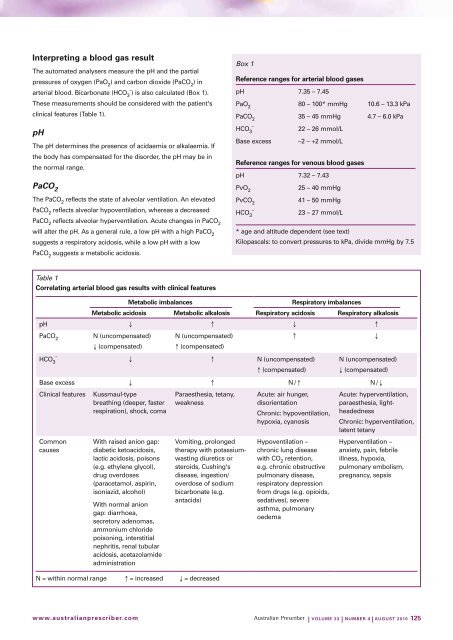The interpretation of arterial blood gases - Australian Prescriber
The interpretation of arterial blood gases - Australian Prescriber
The interpretation of arterial blood gases - Australian Prescriber
Create successful ePaper yourself
Turn your PDF publications into a flip-book with our unique Google optimized e-Paper software.
Interpreting a <strong>blood</strong> gas result<br />
<strong>The</strong> automated analysers measure the pH and the partial<br />
pressures <strong>of</strong> oxygen (PaO 2<br />
) and carbon dioxide (PaCO 2<br />
) in<br />
<strong>arterial</strong> <strong>blood</strong>. Bicarbonate (HCO 3ˉ) is also calculated (Box 1).<br />
<strong>The</strong>se measurements should be considered with the patient's<br />
clinical features (Table 1).<br />
pH<br />
<strong>The</strong> pH determines the presence <strong>of</strong> acidaemia or alkalaemia. If<br />
the body has compensated for the disorder, the pH may be in<br />
the normal range.<br />
PaCO 2<br />
<strong>The</strong> PaCO 2<br />
reflects the state <strong>of</strong> alveolar ventilation. An elevated<br />
PaCO 2<br />
reflects alveolar hypoventilation, whereas a decreased<br />
PaCO 2<br />
reflects alveolar hyperventilation. Acute changes in PaCO 2<br />
will alter the pH. As a general rule, a low pH with a high PaCO 2<br />
suggests a respiratory acidosis, while a low pH with a low<br />
PaCO 2<br />
suggests a metabolic acidosis.<br />
Box 1<br />
Reference ranges for <strong>arterial</strong> <strong>blood</strong> <strong>gases</strong><br />
pH 7.35 – 7.45<br />
PaO 2<br />
80 – 100* mmHg 10.6 – 13.3 kPa<br />
PaCO 2<br />
35 – 45 mmHg 4.7 – 6.0 kPa<br />
HCO 3ˉ<br />
22 – 26 mmol/L<br />
Base excess –2 – +2 mmol/L<br />
Reference ranges for venous <strong>blood</strong> <strong>gases</strong><br />
pH 7.32 – 7.43<br />
PvO 2<br />
25 – 40 mmHg<br />
PvCO 2<br />
41 – 50 mmHg<br />
HCO 3ˉ<br />
23 – 27 mmol/L<br />
* age and altitude dependent (see text)<br />
Kilopascals: to convert pressures to kPa, divide mmHg by 7.5<br />
Table 1<br />
Correlating <strong>arterial</strong> <strong>blood</strong> gas results with clinical features<br />
metabolic imbalances Respiratory imbalances<br />
metabolic acidosis metabolic alkalosis Respiratory acidosis Respiratory alkalosis<br />
pH ↓ ↑ ↓ ↑<br />
PaCO 2<br />
N (uncompensated)<br />
↓ (compensated)<br />
N (uncompensated)<br />
↑ (compensated)<br />
↑<br />
↓<br />
HCO 3ˉ ↓ ↑ N (uncompensated)<br />
↑ (compensated)<br />
N (uncompensated)<br />
↓ (compensated)<br />
Base excess ↓ ↑ N/↑ N/↓<br />
Clinical features Kussmaul-type<br />
breathing (deeper, faster<br />
respiration), shock, coma<br />
Paraesthesia, tetany,<br />
weakness<br />
Acute: air hunger,<br />
disorientation<br />
Common<br />
causes<br />
With raised anion gap:<br />
diabetic ketoacidosis,<br />
lactic acidosis, poisons<br />
(e.g. ethylene glycol),<br />
drug overdoses<br />
(paracetamol, aspirin,<br />
isoniazid, alcohol)<br />
With normal anion<br />
gap: diarrhoea,<br />
secretory adenomas,<br />
ammonium chloride<br />
poisoning, interstitial<br />
nephritis, renal tubular<br />
acidosis, acetazolamide<br />
administration<br />
Vomiting, prolonged<br />
therapy with potassiumwasting<br />
diuretics or<br />
steroids, Cushing's<br />
disease, ingestion/<br />
overdose <strong>of</strong> sodium<br />
bicarbonate (e.g.<br />
antacids)<br />
N = within normal range ↑ = increased ↓ = decreased<br />
Chronic: hypoventilation,<br />
hypoxia, cyanosis<br />
Hypoventilation –<br />
chronic lung disease<br />
with CO 2<br />
retention,<br />
e.g. chronic obstructive<br />
pulmonary disease,<br />
respiratory depression<br />
from drugs (e.g. opioids,<br />
sedatives), severe<br />
asthma, pulmonary<br />
oedema<br />
Acute: hyperventilation,<br />
paraesthesia, lightheadedness<br />
Chronic: hyperventilation,<br />
latent tetany<br />
Hyperventilation –<br />
anxiety, pain, febrile<br />
illness, hypoxia,<br />
pulmonary embolism,<br />
pregnancy, sepsis<br />
www.australianprescriber.com<br />
| Volume 33 | NumBeR 4 | AuGuST 2010 125
















